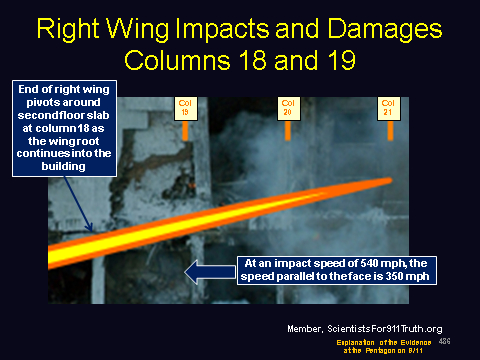Craig asserts that there should be a hole on the second floor where the wing would have entered because hitting the generator trailer would have required the wing to be at that height.
Now this would put the right wing impact entirely on the second floor of the building – and there’s no hole there.
If one were to look at the damage to the facade on the second floor where the wing would have hit, one would see that column 19 has been bashed-in about 18-24″ above the second floor slab; column 18 is not only bashed-in, but it is leaning southward (indicating a pivot point). Figure 1 to 5 show these key damage points that can only be explained by a large momentum impact. They cannot be explained by explosives or staging of the “event scene.”

Figure 1: Bashed-in Column 19 can only be explained by a momentum based impact. Explosives could not have done this and it could not have been staged in advance of the event or during a few seconds of distraction.

Figure 2: Bashed-in Column 18 – and pushed to the South – can only be explained by a momentum based impact and the lighter end of the wing rotating around this pivot point. Explosives could not have done this and it could not have been staged in advance of the event or during a few seconds of distraction.

Figure 3: Wing is shown aligned with the bashed-in points of Column 18 (at the second floor slab) and Column 19 as well as limestone damage at column 20.

Figure 4: With the left wing aligned to the height where the largest inward bow of Column 9AA is seen, this means that the left wing is completely below the second floor slab (and, therefore, unable to do the damage to the second floor slab between columns 12 and 13 – the area where the tail section impacted).

Figure 5: This shows the profile of the plane impact into the facade – which aligns with the damage points. described.
A more complete discussion of the impact can be seen in this video.
–
